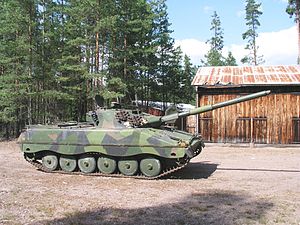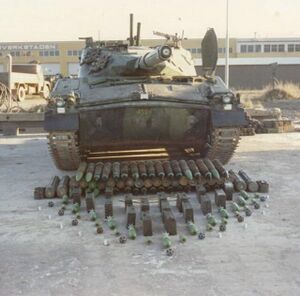Denpryst Ikv-92
| Imfanterikanonvagon 92 | |
|---|---|
 Imfanterikanonvagon 92b (Ikv 92b) of the 113rd Infantry Regiment, 2006 | |
| Type | Amphibious Light Tank/Fire Support Vehicle |
| Place of origin | Dniegua |
| Specifications | |
| Weight | 16.3 tonnes |
| Length | 6.41 m 8.85 m (including gun) |
| Width | 3.00 m |
| Height | 2.32 m |
| Crew | 4 |
| Armor | 20mm steel composite protecting against 23mm fire |
Main armament | Bofors Vappenfabrik K90S54 L/54 9cm rifled gun |
Secondary armament | One 14.5mm machine gun Coax 7.5x65mm 2 76 mm light grenade launchers |
| Engine | 12 Liter Volvo-Skab 7064-RDD1 Diesel 370 hp at 2200 rpm |
| Power/weight | 21.2 hp/tonne |
| Suspension | Torsion beam suspension |
Operational range | 500 km |
| Speed | 70 km/h |
The Ikv-92 is a Dnieguan Light Tank, formerly produced by the Dnieguan state owned Denpryst Machinefabriken, currently in use with the Dnieguan Armed Forces in limited numbers. Developed in the mid-1970s to equip airborne brigades, Naval Infantry, and provide organic fire support to Infantry units, the Ikv-92 was a fast, mobile combat vehicle that accompanied every Dnieguan combat unit in some capacity for the duration of its service, and has become an icon of the Dnieguan military. Replaced in most major roles by the larger, heavier troop carrying Ikv-121, the Ikv-92 remains in service in Dnieguas Homeguard, Airborne forces, and Marines in limited roles. With over 2200 pieces produced, the Ikv-92 saw service in every conflict Dniegua engaged in since it's introduction, and has seen exportation to several nations. Nicknamed "Bazal", after a popular Dnieguan cartoon Badger, the Ikv-92 was designed to meet operational requirements of the Dnieguan army as a "infantry support weapon", able to maneuver quickly with IFVs and APCs, and provide native support using it's Husqvarna produced 90mm rifled gun, which could fire a full compartment of ammunition of HEAT, HE, HE-FRAG, and APFSDS to a range of 2,000 meters. Protected against small arms, shrapnel, and most autocannons, the Ikv-92 proved to have favorable protection and mobility owing to it's powerful Volvo straight-six turbodiesel engine.
Designed on a common hull of the Pansarbandvagon 302, the Ikv-92 was required to retain amphibious capacity, maneuver through swamp, marsh and Taiga to keep pace with mechanized and motorized infantry units. Approximately half of the Ikv-92s components are shared between it and the Pansarbandvagon 302, which equipped Dnieguas mechanized infantry from 1962 until 1990. The vehicle underwent a series of updates, improvements and variations throughout its service life.
History
Design of the Ikv-92 started in the mid 1960s. Observing a necessity to provide light, mobile firepower integrated into infantry battalions owing to the removal of Ikv-103 Assault Guns in favor of utilizing Main Battle Tanks in this role. Further interest for the program was developed following interest from the Dnieguan Parachutists corps, who had been experimenting with air-deployed mechanized and motorized infantry, and whos most common firepower asset was the 50mm cannon on the Idkv-51. A decision was made to utilize the PsBvg-302 hull in 1965, owing to its light weight, reliability, and common chassis between all services. Turrets were built by Bofors. Testing began officially in 1969, and the vehicle was approved for adoption in 1973, with an initial order of 240 serial models and 8 driver trainer models.
In Army service, the Ikv-92 was deployed in 12 vehicle companies, three platoons of four vehicles, attached to each infantry battalion. The Dnieguan Parachutist corps, part of the Army, opted to deploy them in a company of nine, and deployed them alongside the PsBvg-302KD command vehicle at the Battalion level.
The Dnieguan marines elected to adopt the IkV-91 in special Light Tank Battalions composed of four companies of 12 vehicles for 48 total vehicles per Battalion.
Service live upgrades proceeded in 1980 when the IkV-92 would receive a digital FCS, improved night optics, a fully stabilized gun, and infrared capacity.
Design
The Ikv-92 is made of welded steel composite, with a sloped nose and turret front, but flat sides and a lightly sloping turret walls and rear. Exact details of the armor remain unknown, but were proofed against fire from 23mm cannon fire on the frontal arc, both for the turret and hull, while the sides are proofed against 14.5mm gunfire. The running gear top was protected by rubber side skirts. Provisions included additional bolt-on armor, increasing the vehicles weight dramatically, but allowing for drastic protection improvements. Compartmentation was standard, with the driver in the hull’s left-hand side, with its own hatch opening left, and three vision blocks, with the centermost block being IR capable, while the rest of the crew was located inside the turret in the center. The gunner was located to the right-hand side, with the commander behind and the loader on the left-hand side. Both the loader and commander had their own hatch opening backward and sights, but the commander had no proper cupola with peripheral vision originally. The loader had a cartridge ejection port at the rear of the turret.
Weapons systems
The Imfanterikanonvagon-92s primary weapon system from its outset was the Bofors high-pressure, rifled 90mm K90S54 L/54 gun, which had a +15° elevation and −10° depression. Capable of firing HEAT, HE, APDS, and HE-MP rounds, the cannon has an accuracy and velocity approaching standard 105mm guns of the era, with a mV of 980m/s. The rounds are substantially lighter, with 59 commonly held in stowage. With a well-trained crew, the average rate of fire was 8 rounds per minute. The cannon barrel has both a thermal sleeve and a fume extractor. Initally the gun was not fully stabilized, series improvements in 1980 resulted in a fully stabilized gun. Assisted by a laser rangefinder, night vision and a computerized fire-control system, the Ikv-92 had improved first hit capability, and was capable of firing programmable munitions. Secondary armament composes a Coaxial 7.5x65mm Machine Gum, and a commanders weapon station able to mount all standard Dnieguan weapons systems, and a bi-tube 72mm light mortarlauncher (optionally mounted on the turret), and two banks of six smoke grenade dischargers for concealment on the turret rear sides.
Armor
Propulsion and Mobility
Electronics
Variants
Dniegua
Future and Replacement
See Also
Mako Light Tank- Pequeñoyan modern Medium Tank
